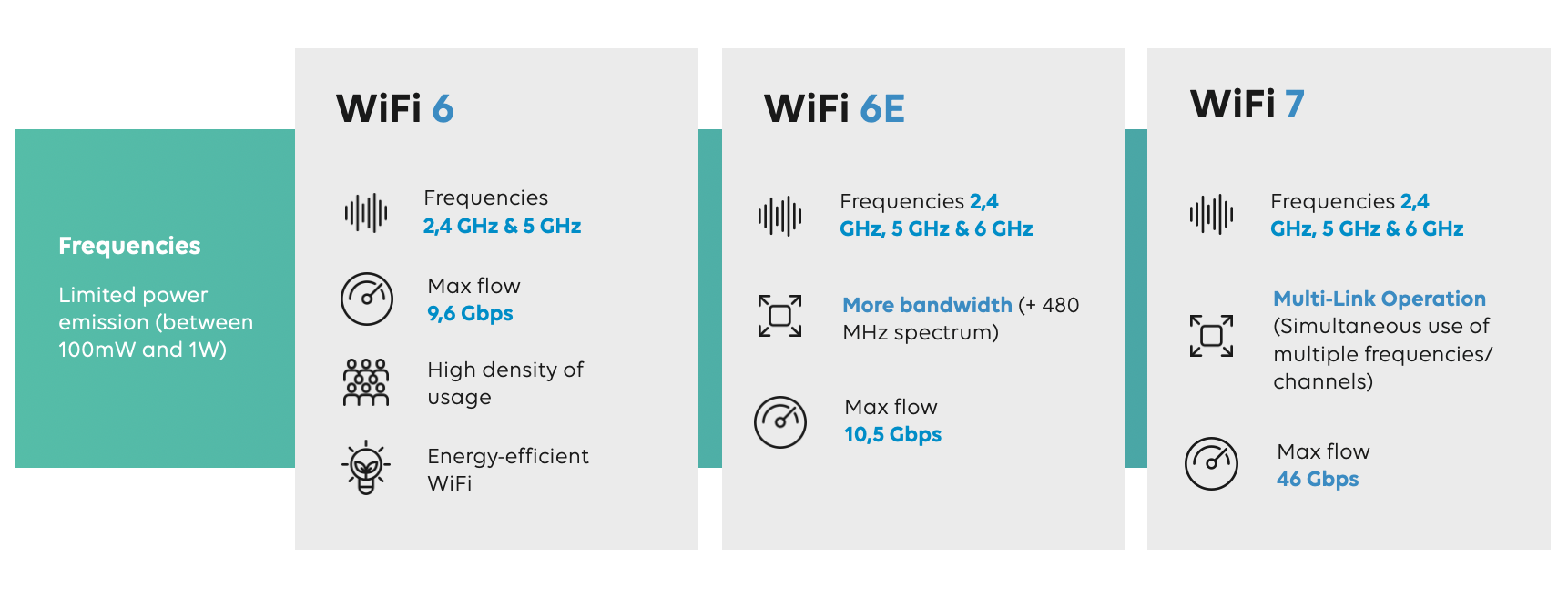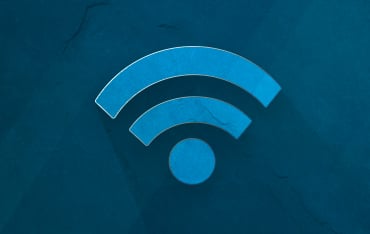Choosing the Right WiFi Standard: WiFi 6, 6E, or 7 for Your Business
WiFi standards are evolving at a steady pace, approximately every 4 years, and their names have become much simpler. Gone are the technical designations like 802.11n, 802.11ac, or 802.11ax; we now talk about WiFi 5, WiFi 6, and WiFi 7. This simplification has made the technology more accessible and has turned WiFi into a real marketing argument for manufacturers and operators.
But beyond the spectacular announcements, how do you find your way and, most importantly, which WiFi standard should you choose for your business? The choice is not limited to novelty. It's a balance between your needs, your budget, and the maturity of the technology.

WiFi 7: Insane Speeds and Breakthrough Innovations
WiFi 7 (or 802.11be) is making headlines with promises of theoretical speeds that can reach 46 Gbps under ideal conditions. This new standard, which began to equip the first consumer and professional products in 2023, is a major step forward.
Its key innovations are:
- The expansion of the 6 GHz band: WiFi 6E paved the way, and WiFi 7 consolidates it. This band, less cluttered by older devices, is a true highway for data.
- Multi-Link Operation (MLO): A revolutionary feature. Instead of using only one frequency band (2.4 GHz, 5 GHz, or 6 GHz), a compatible device can connect to multiple bands simultaneously. This increases throughput by combining channels and makes the connection more reliable by instantly switching to the best band.
- 4096-QAM modulation: This increases the density of data carried by a signal, translating into higher speeds.
- 320 MHz channels: By doubling channel width versus WiFi 6, a much larger volume of information can be transmitted.

WiFi 7 is the solution for the most demanding applications: virtual/augmented reality, 8K streaming, ultra-high-definition video conferencing, and massive file transfers.
The Strategic Choice: Should You Switch to WiFi 7 Now?
Enthusiasm for novelty is understandable, but for a business, the decision to renew its infrastructure must be based on deeper analysis.
1. Features and Service Level
WiFi 6 (or 802.11ax), currently widely deployed, already offers exceptional capacity and performance. It is designed to handle a large number of devices connected simultaneously in dense environments. Thanks to technologies like OFDMA and MU-MIMO, WiFi 6 manages traffic very efficiently—crucial in offices or student residences.
Today, WiFi 6 covers 99.9% of business needs. Remember: a network only performs well if all components are up to standard, including endpoints. In 2025, only a small share of smartphones, computers, and tablets supports WiFi 6E or WiFi 7.
2. Budget and Sustainability
A full WiFi 7 refresh can be costly, and brand-new hardware depreciates quickly. A circular-economy approach often makes sense.
Choosing refurbished professional equipment—such as WiFi 6 or even WiFi 5 access points—can be effective and economical. Network performance depends less on the standard than on design, installation, and monitoring expertise. With solid configuration and maintenance, a WiFi 6 network can outperform a poorly configured WiFi 7 network.
This also supports a responsible digital approach by extending equipment lifespan.
3. The Maturity Time of a Standard
It takes years for a new standard to become mainstream. In early 2025, across student residences we operate on WiFi 6, user sessions by standard were:
- WiFi 6: 55%
- WiFi 5: 27%
- WiFi 4: 18%
Nearly one-fifth of devices still support only WiFi 4 (from 2009). Investing heavily in WiFi 7 makes little sense if most users can’t benefit yet.
Comparative Table of WiFi Standards
| Standard | Technical Designation | Max Theoretical Speed | Frequency Bands | Strengths | Typical Use Case |
|---|---|---|---|---|---|
| WiFi 5 | 802.11ac | up to 6.9 Gbps | 5 GHz | Fast and stable for consumers | HD streaming, home use |
| WiFi 6 | 802.11ax | up to 9.6 Gbps | 2.4 GHz, 5 GHz | Efficiency in dense environments, low latency | Dense environments (offices, schools) |
| WiFi 6E | 802.11ax | up to 10.5 Gbps | 2.4 GHz, 5 GHz, 6 GHz | Adds the 6 GHz band, fewer interferences | Demanding pro and consumer use |
| WiFi 7 | 802.11be | up to 46 Gbps | 2.4 GHz, 5 GHz, 6 GHz | Massive speeds, enhanced reliability (MLO) | Very demanding applications (VR, AI, cloud computing) |
Conclusion
Choosing the right WiFi standard isn’t just about picking the newest one. It’s about aligning performance, budget, and sustainability with your real needs. For most businesses, WiFi 6 remains the most relevant and effective option thanks to its value for money and broad compatibility.
The value of a professional WiFi provider lies in auditing your environment, advising the right solution, and ensuring quality deployment and maintenance—whatever the standard. Before refreshing hardware, verify that current issues aren’t down to configuration.
Want an expert opinion to optimize your company’s network? Contact us for a personalized assessment.
- Wifi (35)
- Hotel Industry (18)
- Digital Workplace (13)
- Behind the scenes (8)
- IPTV - Signage (8)
- Optical fibre (7)
- Green-IT (5)
- Retail (5)
- Education (3)
- Healthcare (2)
- Cybersecurity (1)
- General (1)
- Hospitality (1)
- PBSA (1)
- Student Accommodation (1)
- Telephony (1)
- Tips and tricks (1)
- Tourism (1)
- Wifirst (1)
You May Also Like
These Related Stories

WiFi 6: Revolutionizing Wireless Connectivity and Future Prospects

On our way to WiFi 6E...
